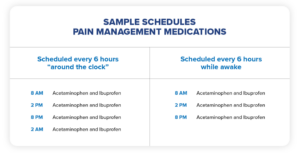Your child’s surgeon may recommend using over-the-counter medications (available without a prescription) such as Tylenol® (acetaminophen) and Motrin® or Advil® (ibuprofen).
Tylenol® and Motrin® each work in different ways to manage pain. They can be given together.
It is important to use the dose your surgeon recommends even if it is different from the dose listed on the medication bottle. The dose on the bottle is based on age, but dosing based on your child’s weight may manage pain better.
Your team may recommend using these medications on a regular basis (“around the clock”) to manage pain. This means giving your child the medications on a set schedule during the day and even at night. Ask your surgeon what dosing schedule to follow, as well as how to give the medications.
While these medications are usually alternated for management of fever, for pain they can be given together. If you give both Tylenol® and Motrin® together (at the same time), this decreases how often you need to give the medication and can be simpler. If you’re giving the medication around-the-clock, it also means less frequent waking up at night. Follow the instructions your care team gives you in terms of how to use these medications and for how long.


This will allow you to manage the pain safely without using more medication than is advised. As with any medications, there are possible serious side effects if used more frequently or at higher doses than prescribed.
You can keep track of medications by making notes on a medication log or on your phone. Write down the name of the medication, the time you gave it, the amount you gave, and when your child can have the next dose. Share this information with anyone else who is also caring for your child, so a dose isn’t accidentally given twice.
Note: Other medications may also contain acetaminophen. Check the labels on any medications you’re giving your child (such as a prescription opioid medication) or other over-the-counter medications to make sure they aren’t already receiving acetaminophen.
For liquid medications, check the concentration on the bottle to make sure you’re giving the correct milligram-based dose.
Have a positive attitude. Be calm, honest, and empathetic but remain in charge. Explain why the medication is helpful.
Only use an oral syringe or medication cup to dose correctly. You can buy these at your pharmacy if they do not come with your medication.
Give your child praise when they take the medication. Some children respond well to a small reward such as a sticker or a chart that leads to rewards.
If your child resists taking the medication, use the syringe to squirt small amounts of medicine into the side of their cheek. This prevents gagging and your child is less likely to spit out the medication.
Ask your pharmacist if you can refrigerate the medication, as the cold temperature may make it easier for your child to take.
Next Page: Opioids